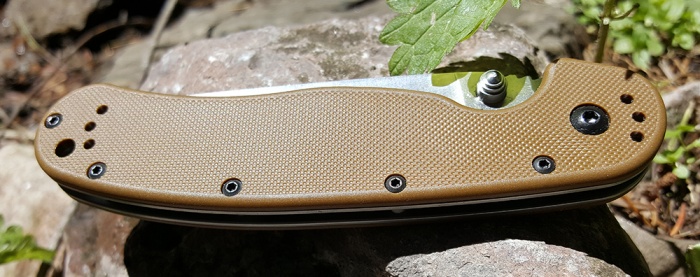The Ontario RAT Model 1 packs a lot of survival knife utility into a budget-friendly package.
When it comes to trail gear, few things are more valuable than a good knife. But in the crowded world of budget blades, which offers the best bang for your buck?
For my money, it just may be the $40 Ontario RAT Model 1. Designed as an all-around outdoors folder, this particular knife comes from the same minds as the popular ESEE fixed blades.
I’ve carried this not-so-little guy through canyons in Colorado, New Mexico, and Arizona. Here’s what I found.
Ontario RAT I Review
In case you’re curious, RAT in this case stands for “Randall’s Adventure & Training.” As the name would indicate, this is a tool built for the outdoors. Ontario Knife Company produces this blade in Taiwan, operating off of survival instructor Jeff Randall’s design. Let’s touch on some of the specs.
First and foremost, the RAT 1 is not a small knife. In fact, everything about it is fairly big. Its D2 steel blade measures 3.625-inches, with the handle adding an even five. This brings the knife’s total length up to 8.625-inches – not exactly something you’d carry to the office, but perfect for tasks around the camp.
It’s also fairly hefty, tipping the scales at just over five ounces.
Despite all this, the RAT 1 manages to be slim where it counts. Its blade is just 0.11-inches thick at the spine of its flat grind, allowing it to slice with surprising delicacy. Its GFN handle is also fairly svelte, spanning just over half an inch.
All of this adds up to a comfortable carrying experience. Oh, and the pocket clip is four-way adjustable, giving users the option of tip-up or tip-down on both the left hand and the right.
I mentioned the blade steel above. D2 does have one notable weakness – namely, its rust resistance. This is a semi-stainless steel, so users will need to exercise care.
Still, its high carbon content makes for strong edge retention and sharpness. If you’ve used a carbon steel blade, you’ll be fine with D2.
It’s worth noting that Ontario also makes several models of the RAT knife with AUS-8 steel.
A RAT in the Hand
Outside of a fixed blade, few knives are easier to operate than this. The RAT 1’s ambidextrous thumb studs help you open the blade, and a beefy liner lock keeps it that way. When you’re ready to stow it, you push the lockbar over with your thumb and gently close the knife. Simple!

The ergonomics here are very good. While the blade has no finger choil to speak of, the spot where the handle draws back around the lockbar is a great place for your index finger.
The blade also has some pretty nice thumb jimping just above the studs. Grip on the GFN surface is excellent. At no point have I feared the knife would slip from my hand.
Here’s another little tidbit – because of its 90-degree spine, the RAT 1 is fully capable of throwing sparks. Though never a first resort, I’ve used it in combination with a firesteel on several occasions.
Just watch the position of your fingers, lest they move the liner lock out of position.
The Competition
That’s the RAT 1 in a vacuum. Let’s take a moment to compare it to two other knives in the same price range – one with a better action, and one with a stronger lock.

Vs. Cutjack: First, the $42 Steel Will Cutjack. Right off the bat, you’ll notice that this and the RAT 1 share the same D2 blade steel. They’re both liner locks, and both blades are within a tenth of an inch of one another (3.5” vs. 3.6”).

But while the RAT relies on thumb studs, the Cutjack has a flipper tab and drop-shut closure. Seems like a big advantage, right? Well, that depends on how much you enjoy maintaining your tools.
While the RAT 1 comes apart and goes back together with ease, I’ve been unable to take down the Cutjack. Its free-spinning pivot has baffled me so far, to the point where I’m afraid further effort would damage the knife. So, needless to say, I won’t be field dressing any game with the Steel Will. Advantage: RAT 1.
Vs. Finn Wolf: Second, let’s take a look at the Cold Steel Finn Wolf ($40). Yes, it’s only running AUS-8A in the blade. But its 3.5-inch Scandi-style grind is practically made for outdoor use.

Add in its relative ease of maintenance (I can take this one apart!) and the durability of its Tri-Ad Lock, and you’re left with a pretty compelling alternative. But here’s the thing – while the Finn Wolf may be a great knife, it’s not one I’d hand to a friend.
Operating the Tri-Ad lock can be a little difficult, especially if you’re tentative when applying pressure. The nylon handle also has a couple hot spots, and one-handed closure requires a fair bit of practice. The RAT 1 has none of these problems. It’s a knife that I can (and do) hand to friends without worrying that they’ll injure themselves.
So, there you have it. The Ontario RAT 1 checks all my requirements: Good ergonomics and blade steel, mated with ease of operation and maintenance.
Conclusion
This is a great knife. Do I wish it were a little lighter? Sure, but I’m willing to trade the extra ounces for its feeling of solidity. And as you’ve seen from the comparisons above, Ontario Knife Company has hit the sweet spot in terms of design, features, and price.
If you need a knife for your loadout, the RAT I is an excellent option.
And if Ontario puts this same steel in the RAT II. I’ll buy one in a heartbeat.











